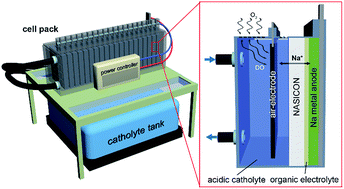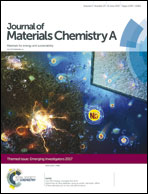Hybrid Na–air flow batteries using an acidic catholyte: effect of the catholyte pH on the cell performance†
Abstract
Metal–air batteries show great promise because of their high theoretical energy density resulting from the use of an unlimited, low-mass O2 gaseous reactant. Nevertheless, several issues remain to be tackled for their practical implementation in ambient air. In this work, we constructed a hybrid-type Na–air battery with a flow-through configuration for direct use of ambient oxygen as the cathode, and studied the effect of the flow of the aqueous catholyte on its electrochemical properties. In addition, the effect of the catholyte pH on the open-circuit and discharge–charge voltage behavior of the hybrid Na–air battery was systematically investigated. An enhanced operation voltage was found for the flow cell using an acidic catholyte composed of 1 M NaNO3 and 0.1 M citric acid (pH = ∼1.8). Further improvement in the cell performance was observed in a cell employing both Pt/C and IrO2 electrocatalysts, which showed an average voltage gap of ∼0.4 V between the charge (∼3.7 V) and discharge (∼3.3 V) voltages vs. Na+/Na at a current rate of 0.1 mA cm−2 over 20 cycles (200 h total). These findings suggest that the hybrid Na–air battery system using a flow-through mode and an acidic catholyte could be a promising way to achieve practical Na–air cells with desirable performance.

- This article is part of the themed collection: Journal of Materials Chemistry A Emerging Investigators


 Please wait while we load your content...
Please wait while we load your content...